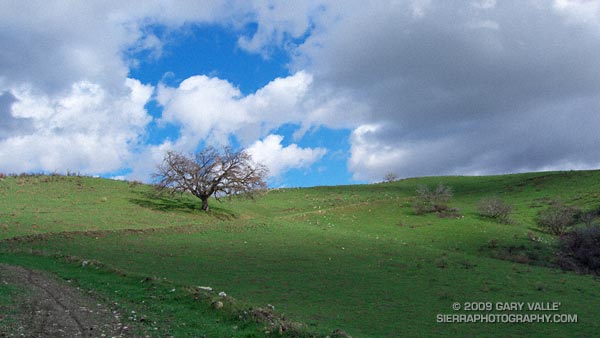
Hill 2484 is near the top of the oil field service road that connects Las Llajas Canyon to Rocky Peak fire road.
From Sunday’s Bandit 30K Course Preview run.
Some related posts: Chumash-Las Llajas Loop, Chumash Trail Rocks & Snow

Hill 2484 is near the top of the oil field service road that connects Las Llajas Canyon to Rocky Peak fire road.
From Sunday’s Bandit 30K Course Preview run.
Some related posts: Chumash-Las Llajas Loop, Chumash Trail Rocks & Snow

Because of a scheduling conflict, two friends weren’t going to be able to enter a challenging new Southern California trail race — the Bandit 30K/14K — so today we previewed the 30K course.
The race starts in Corriganville Park in Simi Valley, and incorporates several of my favorite local trails in Rocky Peak Park. With an elevation gain in excess of 3200 ft., and varied terrain, the race promises to be a memorable test of trail running skill and endurance. A plus is that it is being run in March, when the hills are green; there is water in the creek crossings; and wildflowers along the trails.
So how was the 30K course? In a few words — strenuous, scenic and technical — and more difficult than either the Boney Mountain 21K or Bulldog 22K.
Note: The Bandit Trail Runs are now Rocky Peak Trails.
Related post: Bandit 30K 2009
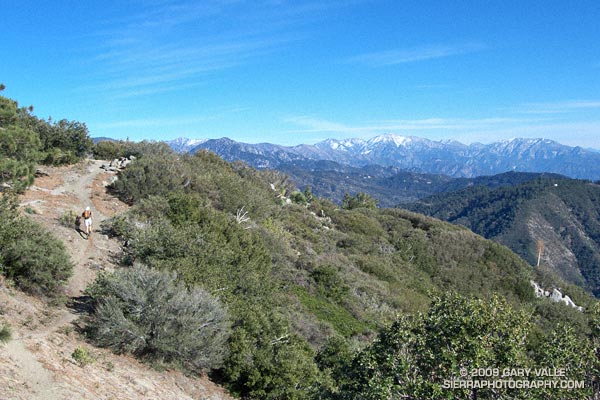
My legs were still pretty worked from the Boney Mountain Half Marathon. Instead of backing off of the pace on my weekday workouts, I had continued to experiment with a change in running technique that was resulting in faster paced runs. I was excited about the increase in speed, but logging fast times on oft-run courses after a strenuous race doesn’t equal recovery. Neither does blasting up a peak in the San Gabriel Mountains.
But it was one of those impossible to ignore, blue sky, short-sleeved Southern California Winter weekends. This would be an unprecedented eighth straight January day that the high temperature in Los Angeles exceeded eighty degrees. In the yin yang of weather, the western half of the U.S. has been enjoying unusually warm temps, while the eastern half of the country shivered.
Taking maximum advantage of the good weather, yesterday I had done a little kayaking on the Kern River, this morning some rock climbing at Stoney Point, and now we were huffing and puffing up Strawberry Peak (6164′) — and doing it “for time.”
We had started at Red Box, the shortest and technically most moderate way to climb the peak. By this route it’s about 3.4 miles to the summit, with an elevation gain of roughly 1600 ft. About two-thirds of that distance is well-graded trail, the rest is steep use trail up a broad, brush covered ridge.
About halfway between Lawlor Saddle and the summit of Strawberry it became plainly and painfully evident that my legs had given their all. I complain. Miklos — always sympathetic — asks why I can’t go any faster.
On the final steep push to the summit ridge I try a different tactic to slow the pace, and tell a story about an unbelievably angry and aggressive raccoon I once encountered near here. But like President Jimmy Carter’s rabbit incident, it loses something in the telling. Redlined, we crest the summit ridge and sprint (relatively speaking) toward the summit.
On the summit, there is not a breath of wind. The view is exceptional. To the southwest, sunlight gleams on the waters of the Pacific near Palos Verdes, and to the west snow gleams white on Mt. Baldy. Some 90 miles distant, near Palm Springs, is the asymmetric silhouette of Mt. San Jacinto.
Soon we’re headed down. As I drop below the summit ridge, a snowball whizzes past my ear, crashing on the trail ahead. It has been warm and dry for weeks, but remarkably, there are a few patches of snow. It is a reminder that Winter is not over, and like the snow, is lurking in the shadows.
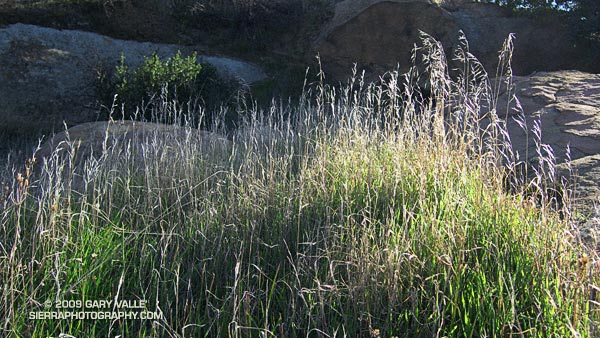
Green beneath Summer’s bleached stalks, the growth of this grass at Sage Ranch reflects the near normal rain season we’ve had to date in the Los Angeles area, and over much of Southern California. Since the start of the water year on July 1, Downtown Los Angeles (USC) has recorded 4.66 inches of rain. When this photograph was taken, January 11th, 4.66 inches was almost exactly normal rainfall for the date.
However, as is so often the case in Southern California, this apparent normality is the sum of offsetting wet and dry periods. December’s precipitation was generally well above normal, but January has been dry, dry, dry. Today, the Los Angeles rainfall total is about 0.5 inch below normal, and every day it doesn’t rain, our deficit increases by about 0.10 inch.
So when might it rain? A very strong 200 kt Pacific jet stream has pushed up a high pressure ridge over the West Coast, blocking storms and warming temperatures. Big upper level ridges such as this are consistent with La Nina, and have been a recurring theme this Fall and Winter. Much of our rainfall and cold weather this season has occurred when an extended Pacific jet collapses or contracts, and a blocking ridge shifts west, opening the door to cold storms plunging down the backside of the ridge from the north.
Over the next 1-2 weeks, this is expected to happen again, but this time there is a wildcard in the mix. One of the reasons the Pacific jet is so strong is the active phase of the Madden-Julian Oscillation (MJO) is present in the Western Pacific. As described in this Climate Prediction Center document, this scenario sometimes leads to a heavy West Coast precipitation event.
It’s too far out for the medium range models to be of much help in assessing the likelihood of such an event developing. At the moment, about the only thing that can be said with some certainty is that a pattern change is in the works, and by the end of January there is a chance of some rain in California and the West. We’ll see!
Related post: Southern California 2008-2009 Winter Precipitation Outlook, Snow on Oat Mountain
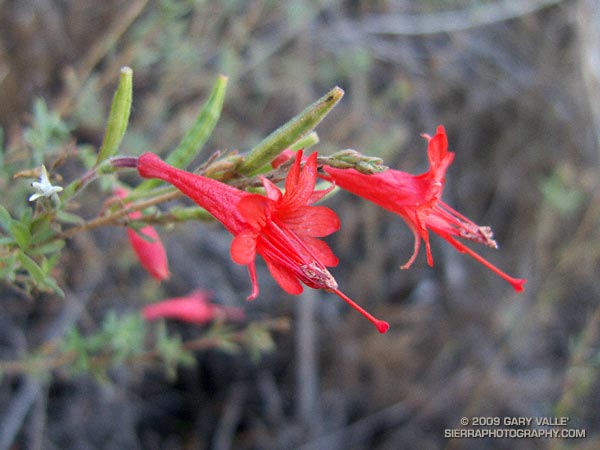
Deep in shade on a north-facing chaparral slope, this California fuchsia (Epilobium canum ssp. canum) has not savored direct sunshine for weeks. Overnight temperatures in the Santa Monica Mountains have dropped to freezing several times this Winter, and frosts have been common. But this hardy plant continues to bloom.
According to the Jepson Manual this subspecies ranges up to about 5000 ft. in elevation, and the parent species up to about 10,000 ft. As a genus, Epilobium is well represented by species that grow at higher latitudes and elevations, and must have developed adaptations that help it flourish in cooler climes.
From a run on the Old Boney Trail on December 27, 2008.
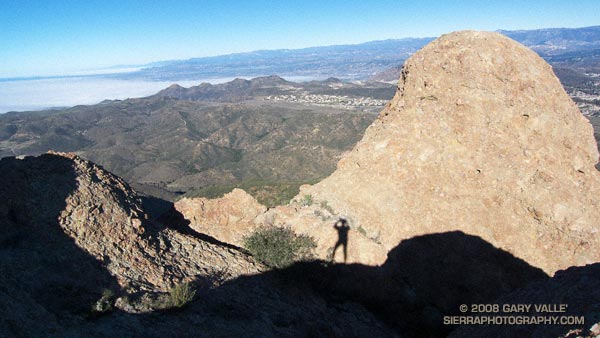
The posts Boney Mountain – Big Sycamore Canyon Circuit and Boney Mountain Western Ridge & Loop describe two routes that ascend the north side of Boney Mountain — a circuitous eastern ridge route, and a more difficult western ridge.
These two routes can be combined into an adventurous loop that starts and ends at the junction of Danielson Road and the Old Boney Trail. The loop, with no side trips, works out to about 4 miles. Add in the 2.5 mile approach from the Wendy Drive trailhead, and the total distance for the course is about 9 miles, with an elevation gain of a bit over 2000 ft.
I did the loop counterclockwise — up the western ridge and then down the eastern. The New Year’s weather could not have been better. Dense fog clung to the coast, but a brisk offshore breeze kept inland views crystal-clear. On the way up the western ridge I couldn’t resist doing a short detour to climb one of the crag’s appealing summits.
At the top of the western ridge, I briefly debated doing Tri-Peaks and Big Dome, but was hoping to make it home by noon, so skipped those side trips.
With gravity on my side, the run down the eastern ridge was not nearly as gnarly as I thought it might be. I was running in Inov-8 Roclite 305s — nimble shoes with a fell running heritage. Mine weigh only 21.1 oz./pair (US 9.0) and were particularly well-suited to the rough terrain.
This climb and adventure run was a great way to start the New Year — and I did make it home in time for lunch with my wife!
Here’s a Google Earth image of a GPS trace of my route.